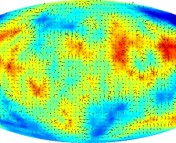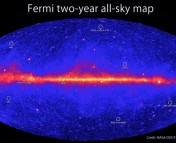Authors: D. Hanson, S. Hoover, A. Crites, et al.
First Author’s Institution: McGill University, Canada.
In this letter, the South Pole Telescope collaboration has measured for the first time a distortion in the polarization of the Cosmic Microwave Background (CMB) caused by gravitational lensing.
Gravitational lensing is the distortion of the path of light caused by gravity. In other words, if you have a light bulb on far away, and a big blob of matter along the line of sight to the light bulb, the light rays coming from the light bulb will be deviated by gravity and as a consequence, you will observe the light bulb to be at a slightly different position from its true position in the sky.
On cosmological scales, the light bulb is the CMB, a screen of light that was emitted roughly 380,000 years after the Big Bang that reaches us today. The CMB is one of our main probes of the properties of the Universe as a whole, a topic recently discussed in these astrobites. Between the CMB and us, there is a web of matter that perturbs the trajectories of the light rays coming from the CMB on their way to us. This is a particular case of gravitational lensing, known as “CMB lensing“.

Polarization fields examples: E-modes have tangential or radial alignments (top two configurations), while B-modes are aligned at 45 degrees (bottom configurations). From Krauss et al.
The CMB is polarized: the CMB light waves do not vibrate in random directions. (This is due to an effect called Thomson scattering and it was discussed in this astrobite.) In the figure to the right, each line represents the direction of vibration of the light of the CMB. At the top, as an example, the light is polarized creating a pattern known as E-mode. At the bottom, the CMB presents B-mode polarization. When the CMB is lensed, the polarization patterns change shape: some of the patterns at the top of the figure above (E-modes) turn into patterns like the ones at the bottom (B-modes). Up to now, B-modes had not been detected, only upper limits were possible. In this letter, the South Pole Telescope collaboration, has measured B-modes in CMB polarization for the first time.
How did they measure this? First, the CMB polarization map has to be decomposed into the contributions from E-modes and B-modes. Then, the effect of gravitational lensing on the CMB, represented by a deflection potential, Φ, needs to be estimated. This is done using a map of the Cosmic Infrared Background from the Herschel telescope, which traces the galaxies that are causing the lensing by observing their dust emission. The lensing potential is responsible for transferring the polarization E-modes into B-modes. By modelling how efficient this transfer should be, it is possible to construct the expected B-modes in the map from a combination of the measured E-modes, the lensing potential and the expected transfer between E- and B-modes. Then one can compare the expected B-modes to the measured ones, as shown in the figure below. The yellow, black and green points are measurements of this correlation between expected B-modes and measured B-mode polarization. The figure shows that B-modes have been detected (the points are very different from the null test, the gray bars) and the measurements are consistent with the expectation (black dashed line) from our current understanding of the Universe.

Detection by the South Pole Telescope of CMB polarization B-modes induced by gravitational lensing. The points in black, yellow and green are the measurements. The dashed line is the theoretical expectation and the gray bars show the result of a null test (a consistency test for a case were there should not be any B-modes). Figure 2 of Hanson et al.
B-mode polarization from gravitational lensing can help set constraints on the amount of matter in the Universe (the source of gravitational lensing) and on cosmological parameters. However, B-modes can also arise from gravitational waves in the early Universe. In this letter, the South Pole Telescope collaboration have focused their efforts on measuring B-modes due to lensing. They suggest that these could, in principle, be subtracted from polarization maps of the CMB to look for B-modes from gravitational waves with the hope to learn more about the physics of the early Universe.




